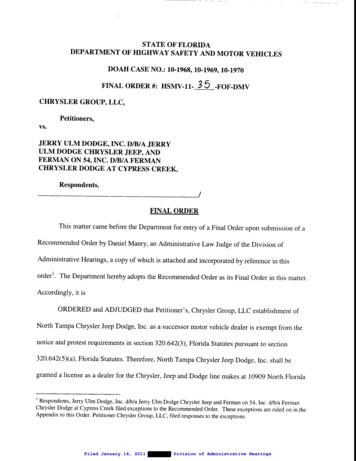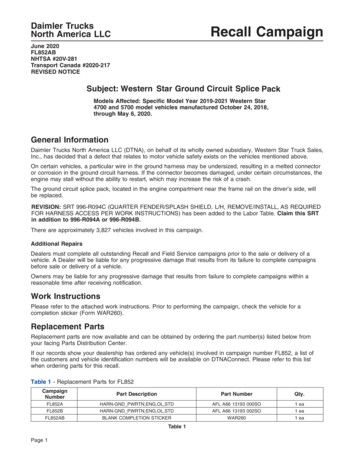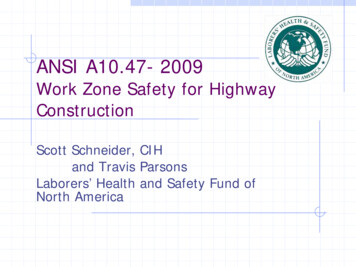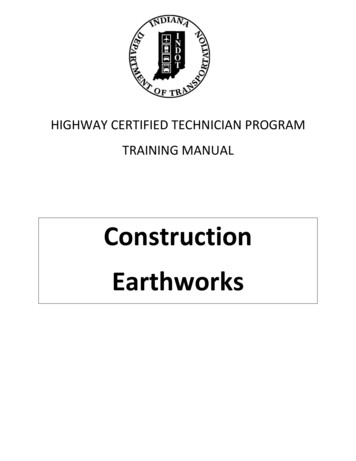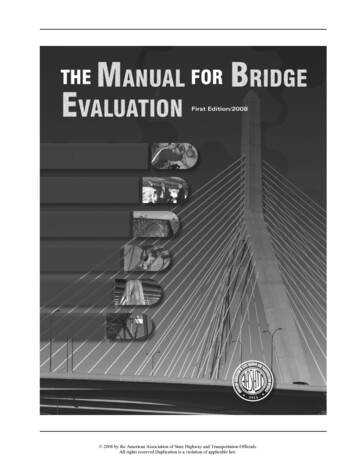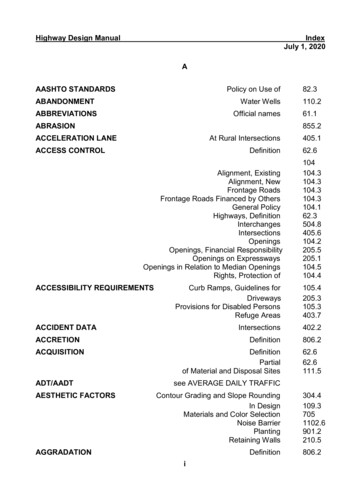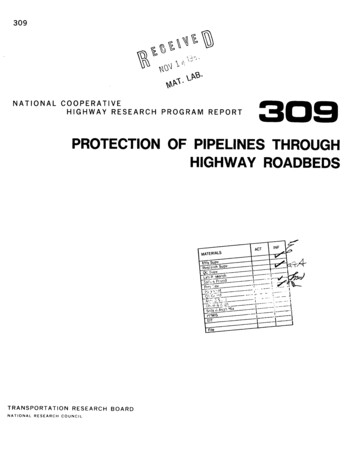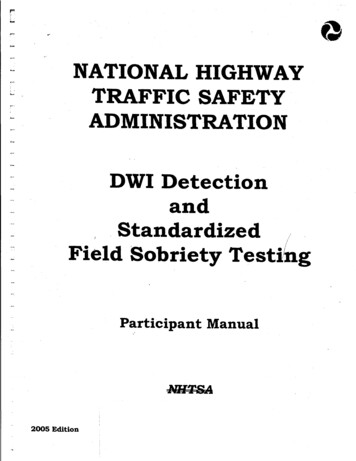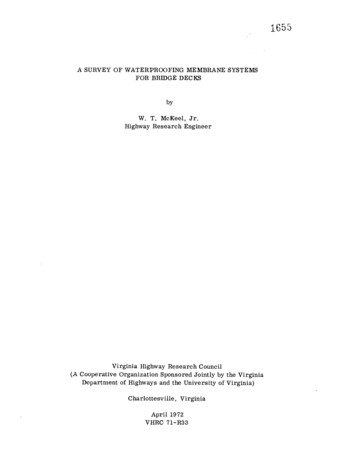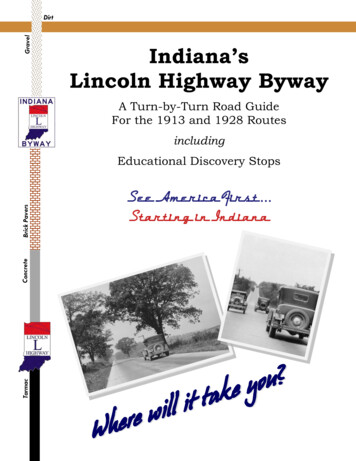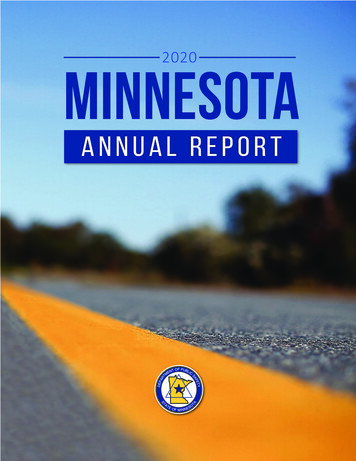
Transcription
2020MINNESOTAANNUAL REPORT
Table of ContentsMessage from the Governor’s RepresentativeExecutive SummaryHighlightsLegislative UpdateCommunity InvolvementMission and Vision StatementPerformance Measures9Telephone Survey34Project SummariesPlanning and Administration38Occupant Protection40Impaired Driving47Police Traffic Services66Traffic Records72Community Programs77Motorcycle Safety88Roadway Safety91Media94Appendix A: Acronyms and DefinitionsAppendix B: SHSP Steering Committee Strategic Direction Work Plan Development and ImplementationAppendix C: Financial RecapAppendix D: OTS Enforcement CalendarAppendix E: Local Minnesota Traffic Safety Initiatives
Office of Traffic Safety Director’s MessageAs a data driven organization, compiling and analyzing accurate crash data is critical to the OTS Mission,as it allows invested stakeholders to better address traffic safety issues by understanding why andwhere crashes are occurring, and who is ultimately impacted.A compilation of these statistics are collated to annually produce in our legislatively mandated annualreport titled Crash Facts: Minnesota Motor Vehicle Crash Facts--2019These resources help to identify where, and to whom valuable resources should be allocated, as well ashow evidence-based countermeasures can be most practically applied. The DPS-OTS goes beyond therequired elements to identify specific data subsets that are over-represented as significant contributingfactors. Essentially, data is the origination point from which all programmatic decisions are made, andby compiling and utilizing reliable data, the Minnesota OTS is demonstrating a continuing commitmentto the proper stewardship of federal and state funds.Noteworthy statistics from 2019: Minnesota traffic fatalities decreased by 17 to 364 deaths in 2019. Seatbelt use compliance was not surveyed in 2020. The 2019 compliance rate was 93.4%. Vehicle miles traveled-based fatality rate in 2019 was 0.599, second best in the nation. Alcohol-related fatalities decreased 9 with 114 fatalities in 2019. Additional information and resources, including the Crash and Impaired Driving Factspublications are located on the OTS website: ots.dps.mn.govLegislativeAs the 2020 session of the Minnesota legislature convened, DPS/OTS was prepared to move severaltraffic safety initiatives forward. These included an oral fluid roadside testing pilot project and animprovement to the existing ignition interlock program. Shortly after the session began, the COVID-19pandemic struck and all non-critical legislative activity ceased. These initiatives will be carried forwardfor possible introduction in the 2021 legislative session.
The Minnesota Department of Public Safety / Office of Traffic Safety (DSP/OTS) has prepared thisreport of our activities and accomplishments for federal fiscal year 202 (FFY20) Annual Report. WhileMinnesota continues to make progress on many fronts as we work tirelessly to prevent serious andfatal motor vehicle crashes on all of Minnesota’s roadways, 2020 has brought significant challenges.The COVID-19 pandemic has affected virtually every aspect of our operations. From delayed andcancelled enforcement and media events to having our entire staff working remotely, nothing has beeneasy. Additionally, Minnesota has experienced significant and widespread civil unrest. The challengesfaced by our law enforcement partners is unprecedented and has only exacerbated the difficulties wehave experienced with our traffic safety programs.This report details our staff and program accomplishments and demonstrates continuedimplementation of proven countermeasures and innovative approaches that will achieve our ultimategoal of Zero Deaths. In spite of the critical challenges we continue to face, we remain focused on ourmission of preventing fatal and serious injury crashes across our state. The following six pillars formthe foundation for our approach to our preventative approach:1. Demonstration of Consistent High PerformanceMinnesota is proud of the fact that we again rank #2 in the nation for the lowest fatality rates pervehicle miles traveled in the nation. We continue to be recognized as a low incidence state forimpaired driving in fatal crashes, and as a high compliance seatbelt use state. Utilizing andimplementing innovative and forward thinking strategies and strong data driven principles we arecontinuing to change driver behavior in positive ways.2. Implementation of Technological EnhancementsIn 2019, the Minnesota OTS continued to engage our partners at the local, regional, and nationallevel continually seeking and sharing new and emerging best practices. DPS/OTS has receivedadditional grant funding through GHSA to support our State’s Drug Recognition Evaluator (DRE)program. As COVID-19 and other societal events impacted our ability to deliver programs andservices, OTS staff worked with both NHTSA and our multiple grantees to allow for the maximumamount of flexibility for each individual program. While some events were curtailed or reduced inscope, we continued to provide resources that positively affected traffic safety across the state.3. Strategic Support of Traffic Safety PartnersMinnesota OTS awarded grants to 23 Safe Roads coalitions across the state. In addition, our nineTZD Regional Directors provided leadership and support to approximately 30 additional unfundedlocal coalitions. Minnesota OTS maintained support for 16 DWI courts and currently continues tosupport eight judicial interlock programs. In addition, 56 multi-agency enforcement grants covered68 sheriffs’ offices, 232 police departments, two tribal enforcement agencies, two university policedepartments, and all districts of the State Patrol. Through a different grant with OTS, the StatePatrol increased the number of DRE active in the State to 268 officers representing 114 agencies.306 officers were trained in Advanced Roadside Impaired Driving Enforcement (ARIDE), and 241officers in Standardized Field Sobriety Test (SFST); finally, they provided 465 officers with the DWIupdate class. Nine program coordinators/subject matter experts on staff, as well as four lawenforcement liaisons and two child passenger safety liaisons outside of the office are available toprovide best practices and guidance to project coordinators. Working in concert with our staff arenine Regional Toward Zero Deaths program coordinators who provide real time and on the groundsupport to a vast array of traffic safety advocates and professionals from all five sectors of the TZDteam: Engineering, Education, Enforcement, Emergency Medical Service providers, and everyonewith a vested interest in traffic safety issues at the local level.
4. Employment of Data-Driven Programming, Research, and EvaluationMinnesota utilizes a robust problem identification process through the analysis of crash data by thetwo and one half researchers and the one and one-half Fatality Analysis Reporting System (FARS)analysts on staff. For FFY20 an improved and more detailed problem identification process wasestablished. We continue to use data as our foundation and are increasingly using more effectiveevaluation tools to ensure that projects and programs are doing their intended work. Wheneverpossible, our projects provide references to chapters and sections in Countermeasures That Workand the State’s Strategic Highway Safety Plan (SHSP) focus area in the annual OTS Highway SafetyPlan (HSP).5. Proactive RecognitionDuring 2019 multiple agencies as well as individual officers from across the State were recognizedfor outstanding traffic safety and engagement efforts during the year. These recognition eventstook place at their county board or city council meetings and during agency roll call briefings. Theserecognition presentations were made to all individual officers, troopers, and deputies as well as toomany support staff members who play a key role in program delivery and operational success.Several individual agencies and their leadership were recognized for their commitment to trafficsafety as a priority even during the ongoing pandemic.6. Increased Traffic Safety Education EffortsMinnesota OTS and Office of Communications (OOC) together provided updated supplementalmaterials for traffic safety advocates, as well as media, education, and law enforcementprofessionals. The materials convey important traffic safety messages, resources for parents andguardians of teen drivers and of children traveling in child seats, and use new creative messagingfor a variety of media platforms to reach targeted audiences through an increased and improvedemphasis on social media. Minnesota DPS/OTS is firmly committed to reaching out to all of ourdiverse communities with these same critical messages. Multiple, nontraditional platforms areutilized to ensure significant outreach with difficult to reach communities and demographic groupsFFY21 has already started off with significant continuing challenges. COVID-19 is once againresurging and, as a result, many of our stakeholders and partners have been forced to restrictactivities and have had to reduce participation in some traffic safety programs. At the same timeour fatality rate is continuing to climb and is well above last year’s level and the 5-year averages. Asthe Minnesota DPS/OTS moves onward with our mission in 2021 we acknowledge thatimprovements in a number of our program areas will need to be made. The OTS is committed to athorough evaluation of each of our projects and programs in order to ensure that we are doingeverything possible to improve overall traffic safety across all of Minnesota. Specifically, we will beevaluating and making adjustments in the following performance target areas: In the area of traffic fatalities, we will leverage current, new, and emerging data sets tospecifically identify root causal factors and then apply appropriate strategies to preventthem. We know that speed has proven to be a major contributing factor in the increase infatalities and we reallocated available resources to address this increasing menace.While our occupant restraint compliance rate appears to be stable (a survey was notconducted in 2020 due to COVID-19 restrictions), 73 unrestrained vehicle occupants werekilled. We are working to identify additional outreach and education opportunities whilealso increasing outreach to our law enforcement partners.
Nearly 90 persons were killed as a result of impaired driving. We will continue to advocatefor policy and legislative solutions that will strengthen our current laws and make themmore effective. The addition of Judicial Liaison Outreach position with specialized trainingand knowledge in the area of impaired driving has proven to be an excellent addition toour overall impaired driving programs. We will continue to evaluate DWI officer supportand adjust as necessary, up to 25 DWI Officers across the entire state .Speed related fatalities continue to plague our entire state. OTS will improve our outreachand educational efforts while also looking for additional ways to support enforcementefforts.In the area of Motorcycle Safety, we will continue to work closely with rider advocacygroups and industry to educate all riders of the importance of helmets and high visibilitygear. With COVID-19 restrictions in place, many of our rider training classes were eithercanceled or moved to the end of the riding season. In 2021 we are anticipating a return toa more normal schedule that will allow us to reach our novice riders early in the season.Close attention and adjustments will be made as evaluation of the program is done.Fifty-six teen drivers were killed in crashes last year. In 2020 OTS will work closely with ournewly formed Teen Driver Safety Task Force and with our partner agency Driver andVehicle Services (DVS) to study and improve teen driver education and testing for all newdrivers. Data collected will be monitored and programs will be adjusted based on taskforce feedback.Minnesota is following the national upward trend in the number pedestrian and bicyclefatalities. In 2021 we will work with the Minnesota Department of Transportation(MnDOT) to expand both education and outreach projects as well as enforcement efforts.With the onset of the COVID-19 pandemic, Minnesota, like many other states, saw a rapid andunprecedented increase in the number of speed attributed fatal crashes. A the same time, our lawenforcement partners reported a parallel increase in the number of serious speed violations beingencountered (especially the number of violations over 100 Miles Per Hour). In response this criticalpublic safety threat in late 2020 the Minnesota TZD program partners (DPS, MnDOT, MDH), all workedjointly to develop a long term and robust speed reduction project. This enforcement and educationcampaign will kick off in the first weeks of 2021 and will carry through the summer months. This effortwill be supported in part with a 1M Section 402 funding amendment to the FFY21 HSP. The fundingwill provide for additional, speed focused, high visibility enforcement and with a corresponding mediaoutreach and education efforts. Data will be evaluated and programs adjusted for 2022 and beyond.Additional resources from MnDOT and MDH in support of this project are also being developed.”In addition, DPS/OTS took the following steps in 2020 to address emerging traffic safety challenges: HSP Amendment #3: Added an additional 100,000 to the DWI Officer grant program. HSP Amendment #6: An Additional 60,000 to Ignition Interlock to support increase inenrollment. HSP Amendment #8: Additional funding to both Occupant Protection and Impaired Drivingprograms to support NHTSA Program Assessments. HSP Amendment #9: Additional 220,000 to Enforcement Support programs to addressspeed and distracted driving behaviors. HSP Amendment #10: An additional 30,000 to Enforcement Support for local agenciesand 10,000 to the State Patrol Enforcement grants to be used to target speed violations.
Regardless of the challenges of 2020 and the unknowns of 2021, the staff and leadership of theMinnesota OTS are proud of our work and the accomplishments made with our traffic safety partnersworking toward a common goal: Zero Deaths. We look forward to continuing this work in theupcoming years. A comprehensive review of the individual projects conducted through the 2020 HSPfollows the performance measure discussion in the body of this report.Sincerely,Michael J. HansonMichael Hanson, DirectorOffice of Traffic Safety, Minnesota Department of Public SafetyP.S. CARES WaiversSeveral Waivers were issued and advantage was taken of the following#1 High Visibility Enforcement#3 Seat Belt Survey#5 Maintenance of Effort#6 Ability to spend grant funds#7 Local BenefitWith the health emergency and the civil unrest many staff in all areas were reassigned thus theredirecting of priorities was impacted.
Community InvolvementThe Community Event Report objective is to inform Commissioner Harrington’s and Governor Walz’soffices about public safety outreach to Minnesota communities provided by CPS Techs, LELs, TZDRegional Coordinators and OTS staff. In 2020, meetings, presentations, classes and events wereattended despite the challenges presented by the COVID-19 pandemic. Innovative solutions wereimplemented to move conferences and other events to virtual formats, which in many cases, enhancedthe ability of traffic safety advocates to reach larger and more geographically disparate audiences. Formore detailed information, see Appendix B.To date some of the meetings, classes, presentations and eventsattended are as follows: C.A.R.S class (Child and Restraint System) DWI Court Commencement Celebration DRE Graduation MMAP Meeting (Mobility for MN Aging Population) MN South Central Investigator’s Coalition Annual Conference Point of Impact Program TZD Stakeholder Breakfast Range TZD Meeting Red Lake Trial Leadership meeting““It was once said that the moral test of government ishow that government treats those who are in the dawnof life, the children; those who are in the twilight of life,the elderly; and those who are in the shadows of life,the sick, the needy and the handicapped.”–Hubert H. HumphreyMinnesota DPS/OTS 2020 Annual Report7
The Office of Traffic Safety MissionTo prevent traffic deaths and serious injuries by changing human behavior inMinnesota through policy development and support, stakeholder engagement,program delivery, leadership, innovation, and research and evaluation.Our signature traffic safety campaign is a multi-agency, holistic program titled Toward Zero Deaths. Inaddition to the Office of Traffic Safety, the Bureau of Criminal Apprehension, Driver and VehicleServices, and the Minnesota State Patrol’s all work together to support the efforts within theDepartment of Public Safety to improve roadway behavior.Toward Zero Death encompasses: City, county, state, and tribal law enforcement personnel Courts and prosecutors Department of Transportation, roadway engineering related prevention strategies Driver and Vehicle Services Emergency Medical Services and First Responders Hospital and trauma oversight by the Minnesota Department of Health Judiciary affiliates Media relationships Stakeholders with direct and indirect interests in trafficsafetyThe overarching goal of Minnesota Toward Zero Deaths“To reduce fatalities and serious injuries on Minnesota’s roads to zero.”MissionTo create a culture for which traffic fatalities and serious injuries are no longer acceptable through theintegrated application of education, engineering, enforcement, and emergency medical and traumaservices. These efforts will be driven by data, best practices and research.VisionAll programs initiated and supported are designed to reduce the numberof people killed in trafficcrashes to zero. Related, is the desire to minimize the number of severe injuries occurring in trafficcrashes. We recognize that fatal and serious injury crashes are not inevitable,and in fact, each is a preventable event.
Performance MeasuresCore performance measures and outcome measures in key traffic safety areas provide realistic targetsand help Minnesota develop programs with the goal of saving lives and making our roads safer. To project and set performance measure targets, MN DPS and MnDOT calculate a rolling five year average ofdata. When yearly data becomes finalized these targets are then adjusted for the next year’s projectedtarget.Several sources of data are used in determining performance measure targets: Fatality Analysis Reporting System annual fie (all fatality measures) Vehicle miles traveled (MnDOT data) State observational survey of seatbelt use (seat belt use rate) State crash data file (serious injuries, 2019 counts and 2020 YTD counts feathering almost 10months of preliminary data) Annual attitude and behavioral survey of Minnesota residentsDue to differing national and state definitions, some core outcome measures (i.e. alcohol impaireddriving fatalities) may differ from literature produced by the State (i.e. Minnesota Motor Vehicle CrashFacts, Impaired Driving Facts).Minnesota made tremendous progress lowering traffic fatalities in the past decade. That downwardtrend is evident examining yearly fatality counts. In fact, the 2017 count of 358 fatalities marked thelowest number of traffic deaths since 1944. Since 2017, there have been increases (381 fatalities in2018 and 364 fatalities in 2019), but the overall trend is decreasing. The fatality rate per 100 millionvehicle miles traveled for 2019 was 0.60; (actually 0.599) this marks the state’s lowest fatality rateever.Minnesotamet or exceededthe 371)2019 target in 8 of the 11 measures: Traffic Fatalities364 (Target Serious injuries 1520 (Target 1,711) Fatalities per 100 million vehicle miles traveled: 0.60 (Target0.62) Alcohol –impaired driving fatalities: 86 (Target 97) Speed related fatalitie
publicationsare located on the OTS website: ots.dps.mn.gov Legislative As the 2020 sessionof the Minnesota legislature convened, DPS/OTS was prepared to move several traffic safety initiatives forward.These included an oral fluid roadside testing pilot project and an improvement to
